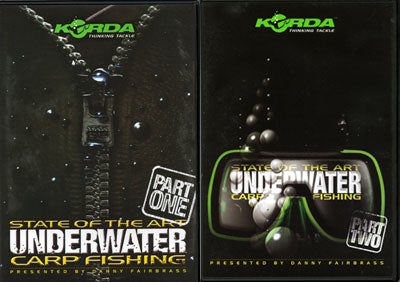KORDA STATE OF THE ART UNDERWATER CARP FISHING DVD PARTS 1 & 2 Although the DVDs were used for review purposes, the videos contain exactly the same footage apart from the ‘Bonus Feature’ on the DVDs. PART 1 This is the film that broke new ground in coarse fishing, the fact that it is aimed at carp fishing in particular does not detract from what can be learned from it in regard to other species. It shows, for the first time, how fish feed by putting a camera right in front of their noses. The film is shot on one very small clear patch of the Carp Society’s famous Horseshoe Lake in Gloucestershire. The presenter, Danny Fairbrass, takes the viewer through a host of rigs and attempts to answer the many questions that arise as the camera sees the fish pick up, or attempt to pick up, the bait. You’ll see a spodful of bait fall through the water and how the fish react to it. You’ll see carp, tench and small silver fish feeding, and how they react to rigs and baits. How the fish react to pop-ups is another eye-opener. The film attempts to answer many questions that previously we could only guess at. PART 2 Part 1 concentrated on fish activity in the swim and gave an insight into fish feeding behaviour. Part 2 continues in that vein but concentrates on the look and mechanics of modern day tackle. The DVD follows a marker float from 80 yards out, right up to the margins, through gravel and sand. Using split-screen technology this footage is married with what Danny is doing on the bank. Rigs are filmed from every angle right from the rig through to the rod, taking a look at and comparing four popular braided, mono and fluorocarbon lines. Baits are picked up off the bottom in a variety of ways, using both running and fixed rigs, stretchy mono lines and non-stretch braids, the split screen showing you the effect on different types of indicator. They look at how rigs settle on the bottom, camouflage options, rigs for weed and gravel, how weed lies on the lake bed, inline and swivel lead options. Bonus features on the DVD include Danny showing you how to make pop-up boilies at the water’s edge. | ||||||
|
Welcome!Log into your account














